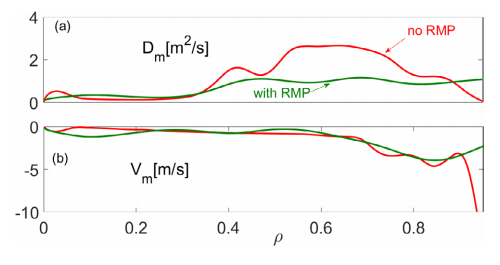
count: [2018-12-22] [Close]
Resonant magnetic perturbation (RMP) is a double-edge sword in fusion device. It can mitigate or suppress the edge localized modes (ELMs), while at the same time it decreases core and plasma edge density, which will reduce the fusion efficiency in the end.
To enhance the long steady state operation of fusion devices, it is crucial to understand the physical mechanism of particle transport in the process of density pump out caused by RMP.
Recently, for the first time, the Far-infrared (FIR) group of the EAST team utilized and modulated the supersonic molecular beam injection (SMBI) to discover the particle transport coefficient change before and after the RMP involvement.
Density pump-out has been observed on EAST under the conditions of mitigated or totally suppressed ELMs with external RMP, associated with decreased core density and degradation of particle confinement.
In order to investigate the particle transport during RMP induced density pump-out, ASIPP scientists performed the density modulation using SMBI to obtain the particle transport coefficients.
The results demonstrate that the diffusive coefficient becomes larger and the inward convection velocity decreases towards the plasma edge after RMP. The measured radial electric field became less negative in the plasma edge,and the shearing rate was reduced significantly, which consequently lead to the plasma density decrease.
This understanding would be useful for improving operational parameters during ELM suppression by RMP on EAST and future fusion devices. (CHU Yuqi reports)
Article link: http://iopscience.iop.org/article/10.1088/1741-4326/aae15a

The change of particle transport coefficients after RMP

Radial electric field and it’s shearing rate decrease in the plasma edge

Density fluctuations increases in the plasma edge after RMP